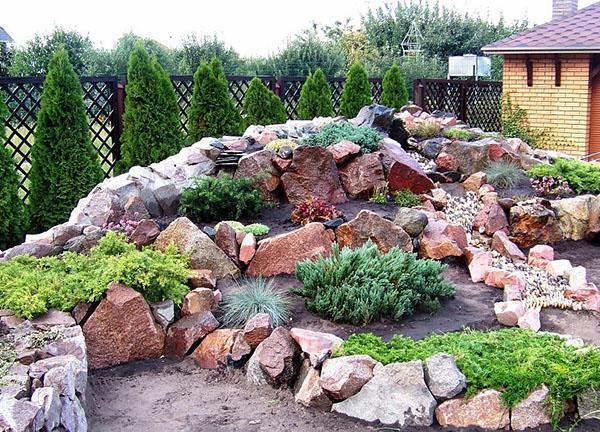Diy three-tiered alpine slide
 The original three-tiered alpine slide is the business card of the owner of the suburban area. It can be used to judge the taste and hard work of the owner. How to do it in the best way? To begin with, it is important to skillfully make rockeries, and then select and distribute plants over it. Here is one of the options for this design.
The original three-tiered alpine slide is the business card of the owner of the suburban area. It can be used to judge the taste and hard work of the owner. How to do it in the best way? To begin with, it is important to skillfully make rockeries, and then select and distribute plants over it. Here is one of the options for this design.
Read also the article in the topic:do-it-yourself alpine slide!
The importance of planning
Choose a place for a landscape masterpiece. It is desirable that it rests against a wall, masonry / brickwork or fence. Do it on a hill, and not out of the blue. The bottom of the front garden is covered with a drainage layer.
The optimal height of the structure is up to 50 cm. If it is higher, then in the northern latitudes the plants will freeze.
The stylistic design of the flower garden depends on the shape, color and size of the stones. They are laid out flat on the site so that they look natural. Cobblestones placed vertically or on the edge will create a mourning effect. Also in this matter, it is important to follow such simple rules:
- at the base of the alpine slide, the largest specimens are placed, the next tier is made of medium stones, and the small ones serve as edging;
- chipped boulders must be of the same color, but of different caliber;
- multi-colored pebbles of the same size look elegant;
- you do not need to make rockery too variegated, combining up to 4-5 shades in a small area.
Up to a dozen plants are planted in the built stone flower garden. However, at first they are laid out in order to visualize how they harmonize with each other. Now it remains to decide on the varieties.
The choice fell on ...
It is necessary to introduce both shrubs and flowering perennials into such a front garden. Complement the composition conifers undersized trees. At the same time, gardeners observe the main rule: no black soil should be visible on the site. Therefore, crops are planted in the following order:
- Loose mint and sedum (sedum) caustic. Needed to revitalize brickwork. It thrives on minimal soil cover, but it is important to stop its growth in time.
- Caragana or yellow acacia. Cascading branches with small openwork foliage of a tall tree will exquisitely decorate the hill.
- Iris marsh... It grows very much in width, and also reaches 1 m in height. Planted in the background.
- Two dwarf coniferous varieties: spruce and spherical western thuja (Danika). Although they are winter hardy, they fade in the sun. Therefore, they are covered with burlap.
- White bloodroot. Throws out the color for the second year. Strongly branched shrub. She needs timely pruning.
- Japanese spirea. The yellow dwarf plant looks great on the middle tier. Moreover, in winter it completely disappears under the snow, since it is very low. In July, it pleases the owners with yellow blooms.
- Iris yellow and purple. They are transplanted from open ground, removing the peduncles so that the seedling can take root painlessly. The roots are sprinkled with earth, without deepening.
- Host. Several varieties are immediately chosen that tolerate the sun. A variety with a yellow and white border, as well as "Satiletto" with thin leaves, is suitable for this business.
- Astilba "Burgundy Red". They plant a tree on the edge of the flower bed so that the carved foliage does not obscure other plants.
- Rejuvenated roofing. Placed in some corner to create a beautiful carpet.
- Alyssum is rocky, in other words, beetroot.It grows well and surprises with abundant spring inflorescences.
- Decorative strawberries. Pink flowers complete the composition at the bottom.
The lifespan of any rockery is 5-6 years. Then the hill is dismantled, the soil and damaged stones are changed, and crops are transplanted.
It is important to remember that if several plants of the same variety are used, then they are planted in groups. Then the alpine slide looks more solid and original. However, some varieties should not be allowed to occupy the entire territory.